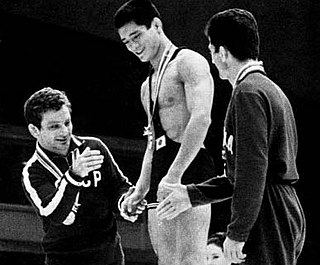The men's freestyle featherweight competition at the 1932 Summer Olympics in Los Angeles took place from 1 August to 3 August at the Grand Olympic Auditorium. Nations were limited to one competitor. This weight class was limited to wrestlers weighing up to 61kg.
The men's freestyle bantamweight competition at the 1936 Summer Olympics in Berlin took place from 2 August to 5 August at the Deutschlandhalle. Nations were limited to one competitor. This weight class was limited to wrestlers weighing up to 56kg.
The men's Greco-Roman featherweight competition at the 1948 Summer Olympics in London took place from 3 August to 6 August at the Empress Hall, Earls Court Exhibition Centre. Nations were limited to one competitor. Featherweight was the third-lightest category, including wrestlers weighing 57 to 62 kilograms.
The men's Greco-Roman lightweight competition at the 1948 Summer Olympics in London took place from 3 August to 6 August at the Empress Hall, Earls Court Exhibition Centre. Nations were limited to one competitor. Lightweight was the fourth-lightest category, including wrestlers weighing 62 to 67 kilograms.
The men's Greco-Roman heavyweight competition at the 1948 Summer Olympics in London took place from 3 to 6 August at the Empress Hall, Earls Court Exhibition Centre. Nations were limited to one competitor. Heavyweight was the heaviest category, including wrestlers weighing over 87 kilograms (191.8 lb).
The men's freestyle light heavyweight competition at the 1948 Summer Olympics in London took place from 29 July to 31 July at the Empress Hall, Earls Court Exhibition Centre. Nations were limited to one competitor. Light heavyweight was the second-heaviest category, including wrestlers weighing 79 to 87 kilograms.
The men's Greco-Roman bantamweight competition at the 1952 Summer Olympics in Helsinki took place from 24 July to 27 July at Messuhalli. Nations were limited to one competitor. Bantamweight is the second-lightest category, including wrestlers weighing 52 to 57 kilograms.
The men's Greco-Roman featherweight competition at the 1952 Summer Olympics in Helsinki took place from 24 July to 27 July at Messuhalli. Nations were limited to one competitor. Featherweight was the third-lightest category, including wrestlers weighing 57 to 62 kilograms.

The men's Greco-Roman flyweight competition at the 1964 Summer Olympics in Tokyo took place from 16 to 19 October at the Komazawa Gymnasium. Nations were limited to one competitor. Flyweight was the lightest category, including wrestlers weighing 52 kilograms (114.6 lb).

The men's Greco-Roman bantamweight competition at the 1964 Summer Olympics in Tokyo took place from 16 to 19 October at the Komazawa Gymnasium. Nations were limited to one competitor. Bantamweight was the second-lightest category, including wrestlers weighing 52 to 57 kilograms.
The men's Greco-Roman featherweight competition at the 1964 Summer Olympics in Tokyo took place from 16 to 19 October at the Komazawa Gymnasium. Nations were limited to one competitor. Featherweight was the third-lightest category, including wrestlers weighing 57 to 63 kilograms.
The men's Greco-Roman welterweight competition at the 1964 Summer Olympics in Tokyo took place from 16 to 19 October at the Komazawa Gymnasium. Nations were limited to one competitor. Welterweight was the third-heaviest category, including wrestlers weighing 70 to 78 kilograms.
The men's Greco-Roman middleweight competition at the 1964 Summer Olympics in Tokyo took place from 16 to 19 October at the Komazawa Gymnasium. Nations were limited to one competitor. Middleweight was the third-heaviest category, including wrestlers weighing 78 to 87 kilograms.
The men's Greco-Roman light heavyweight competition at the 1964 Summer Olympics in Tokyo took place from 16 to 19 October at the Komazawa Gymnasium. Nations were limited to one competitor. Light heavyweight was the second-heaviest category, including wrestlers weighing 87 to 97 kilograms.
The men's Greco-Roman heavyweight competition at the 1964 Summer Olympics in Tokyo took place from 16 to 19 October at the Komazawa Gymnasium. Nations were limited to one competitor. Heavyweight was the heaviest category, including wrestlers weighing over 97 kilograms (213.8 lb).

The men's freestyle flyweight competition at the 1964 Summer Olympics in Tokyo took place from 11 to 14 October at the Komazawa Gymnasium. Nations were limited to one competitor. Flyweight was the lightest category, including wrestlers weighing up to 52 kilograms (114.6 lb).

The men's freestyle featherweight competition at the 1964 Summer Olympics in Tokyo took place from 11 to 14 October at the Komazawa Gymnasium. Nations were limited to one competitor. Featherweight was the third-lightest category, including wrestlers weighing 57 to 63 kilograms.

The men's freestyle welterweight competition at the 1964 Summer Olympics in Tokyo took place from 11 to 14 October at the Komazawa Gymnasium. Nations were limited to one competitor. Welterweight was the fourth-heaviest category, including wrestlers weighing 70 to 78 kilograms.
The men's freestyle middleweight competition at the 1964 Summer Olympics in Tokyo took place from 11 to 14 October at the Komazawa Gymnasium. Nations were limited to one competitor. Middleweight was the third-heaviest category, including wrestlers weighing 78 to 87 kilograms.
The men's freestyle heavyweight competition at the 1964 Summer Olympics in Tokyo took place from 11 to 14 October at the Komazawa Gymnasium. Nations were limited to one competitor. Heavyweight was the heaviest category, including wrestlers weighing over 97 kilograms (213.8 lb).





